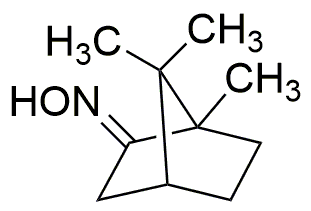(1R)-Camphor oxime is widely utilized in research focused on:
- Pharmaceutical Development: This compound serves as an important intermediate in the synthesis of various pharmaceuticals, particularly in the development of analgesics and anti-inflammatory drugs.
- Organic Synthesis: It is commonly used in organic chemistry as a reagent for the preparation of oxime derivatives, which are crucial in the synthesis of more complex organic molecules.
- Fragrance Industry: Due to its pleasant aroma, (1R)-Camphor oxime is incorporated into perfumes and scented products, enhancing their olfactory profiles.
- Polymer Chemistry: This compound acts as a stabilizer in certain polymer formulations, improving the durability and performance of plastics and coatings.
- Biochemical Research: Researchers utilize it in studies related to enzyme activity and metabolic pathways, providing insights into biological processes and potential therapeutic targets.
General Information
Properties
Safety and Regulations
Applications
(1R)-Camphor oxime is widely utilized in research focused on:
- Pharmaceutical Development: This compound serves as an important intermediate in the synthesis of various pharmaceuticals, particularly in the development of analgesics and anti-inflammatory drugs.
- Organic Synthesis: It is commonly used in organic chemistry as a reagent for the preparation of oxime derivatives, which are crucial in the synthesis of more complex organic molecules.
- Fragrance Industry: Due to its pleasant aroma, (1R)-Camphor oxime is incorporated into perfumes and scented products, enhancing their olfactory profiles.
- Polymer Chemistry: This compound acts as a stabilizer in certain polymer formulations, improving the durability and performance of plastics and coatings.
- Biochemical Research: Researchers utilize it in studies related to enzyme activity and metabolic pathways, providing insights into biological processes and potential therapeutic targets.
Documents
Safety Data Sheets (SDS)
The SDS provides comprehensive safety information on handling, storage, and disposal of the product.
Product Specification (PS)
The PS provides a comprehensive breakdown of the product’s properties, including chemical composition, physical state, purity, and storage requirements. It also details acceptable quality ranges and the product's intended applications.
Certificates of Analysis (COA)
Search for Certificates of Analysis (COA) by entering the products Lot Number. Lot and Batch Numbers can be found on a product’s label following the words ‘Lot’ or ‘Batch’.
*Catalog Number
*Lot Number
Certificates Of Origin (COO)
This COO confirms the country where the product was manufactured, and also details the materials and components used in it and whether it is derived from natural, synthetic, or other specific sources. This certificate may be required for customs, trade, and regulatory compliance.
*Catalog Number
*Lot Number
Safety Data Sheets (SDS)
The SDS provides comprehensive safety information on handling, storage, and disposal of the product.
DownloadProduct Specification (PS)
The PS provides a comprehensive breakdown of the product’s properties, including chemical composition, physical state, purity, and storage requirements. It also details acceptable quality ranges and the product's intended applications.
DownloadCertificates of Analysis (COA)
Search for Certificates of Analysis (COA) by entering the products Lot Number. Lot and Batch Numbers can be found on a product’s label following the words ‘Lot’ or ‘Batch’.
*Catalog Number
*Lot Number
Certificates Of Origin (COO)
This COO confirms the country where the product was manufactured, and also details the materials and components used in it and whether it is derived from natural, synthetic, or other specific sources. This certificate may be required for customs, trade, and regulatory compliance.


